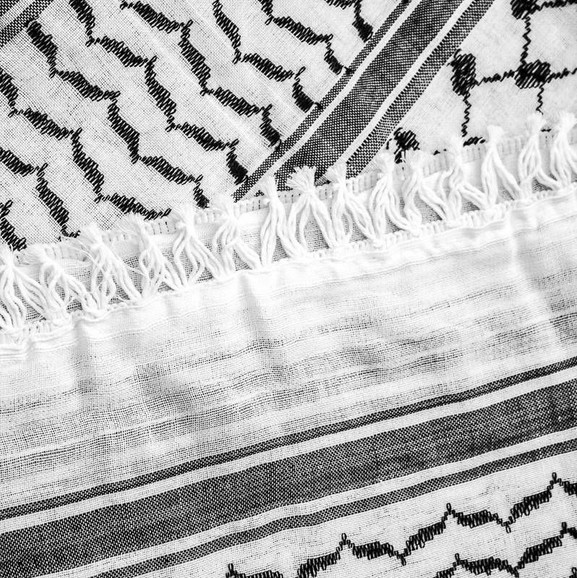
Symbolic Depths of the Palestinian Keffiyeh Pattern
Posted by Mai Wazani on 28th Aug 2024
Have you ever been intrigued by the mesmerizing intricacies of the Palestinian keffiyeh pattern and its profound implications for Palestinian heritage? The Palestinian keffiyeh pattern stands as a profound emblem of Palestinian culture, a motif that has transcended time and borders, uniting people in solidarity with the Palestinian cause. Despite its widespread recognition, the profound historical context and cultural connotations of this pattern often remain concealed from view. In this discourse, we embark on a journey through the annals of the Palestinian keffiyeh pattern's history, delving into the meanings concealed within its exquisite design, while also delving into the importance of complexity and vibrancy in written expression.

Unearthing the Ancestral Origins of the Palestinian keffiyeh Pattern
Emerging from the early 20th century, the Palestinian keffiyeh pattern found its genesis among Palestinian farmers and shepherds who initially donned it as a pragmatic shield against the relentless sun and encroaching dust. Nonetheless, this simple yet captivating design rapidly metamorphosed into a symbol of resilience and identity during the 1960s. Palestinian activists and freedom advocates adorned themselves with the Palestinian keffiyeh to manifest their unwavering support for their cause, galvanizing a movement that still resonates today.
The Cultural Allegories Within the Palestinian keffiyeh Pattern
Comprising a tapestry of three distinct motifs—the fishnet, olive leaves, and bold lines—the Palestinian keffiyeh pattern holds a tapestry of historical and cultural allegories that interweave deeply within Palestinian society.
The Fishnet Weave

Fishing, entrenched in Palestinian tradition for generations, has cultivated vibrant coastal communities along the Mediterranean and the Sea of Galilee. A myriad of fishing techniques—handline, net, and trap fishing—comprise the tapestry of Palestinian fishing heritage. Yet, this industry contends with multifarious adversities, including territorial restrictions and limited access to resources, while competing with Israeli counterparts. Imposing strict boundaries in Gaza's coastal waters, the Israeli administration severely impacts the livelihoods of Palestinian fishermen, exemplifying their resilience amid trials. Their enduring commitment underscores the cultural resonance of fishing within Palestinian society, venerating their tenacity and dedication.
Olive Branches: Emblematic of Resilience

Olive trees, irrevocably intertwined with Palestinian life, bear immense cultural and economic weight. Symbolizing peace, prosperity, and unyielding resolve, these trees possess deep roots within Palestinian history. An integral aspect of Palestinian agriculture, they yield sustenance for numerous farmers and yield precious olive oil, an indispensable element of Palestinian cuisine and cultural rituals. While their economic significance prevails, olive trees serve as poignant symbols of Palestinian identity and defiance. Weathering adversity, including land expropriation and water scarcity due to the Israeli occupation, Palestinian farmers remain resolute in their quest to preserve their heritage and assert their right to autonomy.
Intricacies of the Incense Route

An ancient trade route, the Incense Route, intertwines with a Palestinian cultural tapestry, connecting the Mediterranean with far-reaching lands such as Arabia, India, and East Africa. Named after the valuable incense traded along its paths, this route boasted branches that traversed from Jerusalem to the sacred city of Mecca, profoundly revered in Islam. The conduit for exchanging luxury goods, ideas, religion, and culture, the Incense Route shaped the Middle East's economic landscape. For Palestinian farmers, this route echoes a historical melody, a testament to their cultural heritage and agricultural legacy. Highlighting Palestine's strategic position as a nexus of civilizations and trade routes, this route resonates as a tribute to the mosaic of history.
The Present-Day Poignancy of the Palestinian keffiyeh Pattern
Today, the Palestinian keffiyeh pattern endures as a compelling emblem of Palestinian identity and resistance. However, it has also been adopted by commercial entities and fashion houses, triggering pertinent questions concerning cultural appropriation and the commodification of Palestinian culture.
The Palestinian keffiyeh pattern remains an indelible reflection of Palestinian heritage, reverberating globally as a symbol of solidarity and defiance. The triad of motifs—the fishnet, olive leaves, and bold lines—achingly narrates the saga of Palestinian history, legacy, and identity. As we continue to marvel at the Kufiya pattern's exquisite allure and resonance, it's imperative to acknowledge its cultural significance and stand in solidarity with the Palestinian journey toward self-determination and justice.

